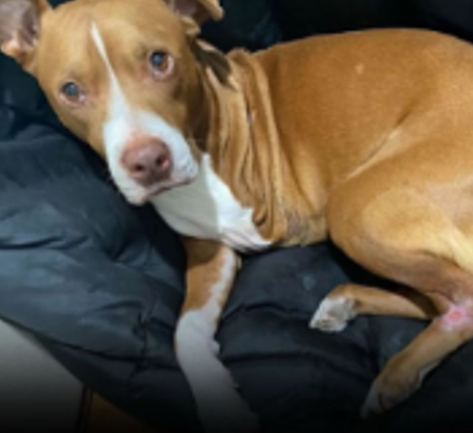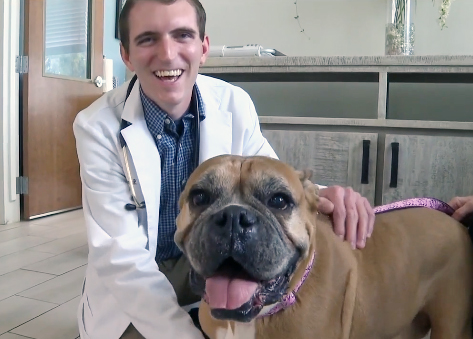STELFONTA® (tigilanol tiglate injection) in the News
Veterinarians are discovering, offering, and using STELFONTA for the treatment of mast cell tumors (MCTs) in their canine patients. Not only have several television stations around the country shared these success stories, but dog owners are also discussing STELFONTA as a treatment option on social media.
Owners are spreading the word about this novel treatment by sharing photos of their dogs and chronicling their STELFONTA treatment. These stories on Facebook, Instagram, TikTok, etc., are inspiring owners to discuss STELFONTA as a treatment option with their veterinarians when they learn the unsettling news that their dog has been diagnosed with a MCT.
Committed to learning all available options for their beloved canine companions, some dog owners that were unable to receive STELFONTA treatment at their regular veterinary hospital sought and successfully found treatment elsewhere.
Some of these great stories featured on TV shows all over the US are below.
Annabel Lee’s Three legged Challenge
Annabel Lee, an eight-year-old American Pit Bull with a heart of gold and gentle disposition, captured the hearts of owners Alicia and Andrew Alderson when they rescued her from Gainsville-based Plenty of Pit Bulls in April of 2017.
“She ran into our arms. It was just love at first sight,” Alicia shared in an ABC20 story.1
However, their journey took a devastating turn in 2023 when they discovered a three-centimeter cutaneous mast cell tumor on Annabel Lee's rear left leg below the hock. Traditional surgical options were ruled out due to her unique circumstance of having only three legs—her front left leg had previously been amputated.
Enter STELFONTA, a non-surgical intratumoral injection specifically designed to target canine MCTs. Fortunately, Annabel Lee was an ideal candidate for STELFONTA and was treated under the care of Dr. Emily Moser, managing veterinarian at Town and Country Veterinarians and Pet Resort in Gainesville. Dr. Moser instructed Annabel’s owner to give Annabel the mandatory medications prior to Annabel’s injection, including a corticosteroid and H1 and H2 blocking agents. These medications decrease the risk of mast cell tumor degranulation which can cause severe systemic reactions, including death
“It’s fantastic, I mean that’s the best part of my job when I can help an animal, and having new tools in my toolkit to be able to help is wonderful,” Moser said.
The treatment and healing process was complete in only a month, providing Annabel Lee with years of life she wouldn’t have otherwise. Today, Annabel Lee is cancer-free and back to her normal, playful self.
Alicia added that as she cannot have children; Annabel Lee is a special part of their lives and a valued part of their family of three dogs. They believe that’s how their family was meant to be.

Bailey Bounces Back
Christina Baker thought it was just a mole. “It really didn’t look that serious,” she says.
But the growth on Christina’s 9-year-old boxer, Bailey, grew and grew, until Christina realized she’d better have Bailey examined by a veterinarian.
Dr. William Smith with Cheval Animal Hospital in Hillsborough County, Florida, confirmed the growth was any pet owner’s worst fear: cancer. Bailey had developed a mast cell tumor on her tail.
According to television station WFTS in Tampa Bay, Dr. Smith told Christina that Bailey faced two options. The first one included surgery, which would most likely result in amputation of Bailey’s tail.
The second option was non-surgical: an injection of STELFONTA® (tigilanol tiglate injection).
This case would be Dr. Smith’s first experience with the product, he told WFTS, making Bailey a bit of a pioneer in the Tampa Bay area. Dr. Smith says he injected STELFONTA into the affected area in hopes the mass would “fall off.”
“It worked beautifully,” Christina told the station. “It was really exciting but kind of scary. My husband was really worried. You are trying a new thing that hasn’t been tried a whole lot of times.”
Christina said Bailey was a bit lethargic after treatment, but the next day, “she was like her normal self,” Christina told the station.
More than 18 months after the treatment, Bailey is as “playful and healthy” as ever, according to the station.
Christina says she hopes Bailey’s story inspires other pet owners and veterinarians to consider using STELFONTA to treat mast cell tumors.
Amputation has been reported as a result of extensive swelling and wound formation in some STELFONTA cases.
"This is really exciting and if your dog fits the parameter, I think it's something you should really consider," Christina told the station.

Max Finds an Alternative
When Danielle R’Bibo found out that Max, her young golden retriever, had developed a mast cell tumor, she thought surgery and amputation was the only answer.
Because the tumor was on his paw, Max faced the possibility of losing a few toes and having mobility issues for the rest of his life. He was just a puppy when the tumor was discovered.
The news was especially difficult for Danielle, since she had recently lost an older pet.
But the night before the procedure was to take place, Danielle received a phone call from her veterinarian’s office.
“They (her veterinarian) called me and said, `There’s an alternative. This medicine is called STELFONTA’” Danielle told New York TV station Pix 11.
Instead of surgery, Max was treated with a single injection of injection of STELFONTA® (tigilanol tiglate injection) and the required concurrent medications..
The three-year-old dog is now running and playing like a normal pup, the station says.
“What’s crazy and unique about this drug is, three to seven days after I inject it into a dog’s mast cell tumor, the tumor falls off,” Max’s veterinarian and veterinary cancer specialist Dr. Sue Ettinger told the station. “And they have an open wound that heals on their own over four to six weeks after the injection.”
Dr. Ettinger says STELFONTA saved Max’s toes, not to mention a lifetime of mobility problems.
“Before STELFONTA was available, we would have had to amputate his two middle toe digits, which are his weight-bearing ones,” she told the station.
All though this particular case did not result in an amputation, some of these cases have resulted in amputation.
Even though Max is now cancer-free, he is required to visit his veterinarian for check-ups.
Danielle and her family couldn’t be happier, she says.
“I’m very happy,” she told the station. “My kids love to play with him. He loves to play ball. I just think it would be very sad for him and for all of us if he couldn’t be his playful, jumping self.”

Dixie Does It
In Atlanta, GA, an 8-year-old boxer named Dixie was treated for a mast cell tumor, according to Atlanta television station 11Alive. Ally Heck, Dixie’s owner, shared her decision to search for STELFONTA after her regular veterinarian saw the tumor and "said we really can't do anything,” Ally says. “So we went to a specialist who said, 'amputate her leg' due to the location of her tumor."2
STELFONTA is indicated for cutaneous mast cell tumors all over the body, and for subcutaneous mast cell tumors distal to the elbow or hock.
Ally says she wanted to see if there was an alternative, so she began to research treatment options for mast cell tumors and she ran across STELFONTA.
Ally eventually found a veterinarian, Dr. Will Gholston, who was open to trying the treatment. "He said I've never heard of that, but I'll do it,” Ally told 11Alive2. “And I think he was the first general vet in our state to be able to do it.”
Ally said Dixie was “off her game for about a week” after the injection. But then she returned to her normal, playful self, getting her boxer wiggle back.2
In a clinical study, Quality of Life (QoL) was assessed by owners rating their dogs in the categories of happiness, mental state, pain, appetite, hygiene, water intake and mobility. The treatment group (81 dogs treated with STELFONTA) were slightly less active and less mobile at day 7 post injection. However at day 14 the QoL scores were equivalent or superior to the control group (42 dogs that were untreated)3.
Ally says the tumor disappeared. “(Her paw has) been tested multiple times and there’s no cancer,” she told the station. “The cancer is dead. It’s gone. There are no words.”2
In a clinical study, 89% of dogs achieving initial complete response at 28 days post treatment were still disease-free at 12 months.4
Appropriate pre- and post-treatment medications must be given, including a corticosteroid plus blocking agents for both H1 and H2 receptors, in order to decrease the potential for severe systemic adverse reactions, including death, from mast cell degranulation.
Scout’s Second Round
When Fort Worth, TX resident Laura Bates rescued a six-month-old boxer from a Texas puppy mill, little did she know the rocky road that lay ahead for both of them. Laura and the pup, Scout, bonded immediately and soon the two became inseparable, according to TV station WFAA. “My No. 1 question whenever I go out or over to someone’s house is, 'Can I bring my dog?,’” Bates told the station. “I’m that person.”5
Not long after Scout celebrated her first birthday, a tumor was discovered on her abdomen. Bates acted fast, having the tumor removed surgically. But a little more than a year later, a tumor struck Scout again, this time affecting her paw5. Options, Scout’s veterinarian told her, included chemotherapy, surgery, even amputation, according to WFAA.
There was another possibility, though: Scout’s veterinarian had heard of a canine mast cell tumor treatment called STELFONTA, but she had yet to actually administer it. Bates and her veterinarian began to research STELFONTA. Her veterinarian told her to do her due diligence and research the treatment option and understand the risks involved. Eventually, the two put their heads and notes together and decided to try this treatment.
STELFONTA was injected directly into the mast cell tumor. According to WFAA, the tumor died but an ugly wound was left behind. “They prepare you that it’s going to look worse before it looks better, and I would say it wasn’t the best thing to look at. But that only lasted for about nine days” Bates told the station.5
The wound was soon replaced by skin and hair, and since her treatment, Scout’s been cancer-free.5 You can follow Scout’s adventures on Instagram.
Formation of wounds, possibly extensive, is an intended and likely response to treatment with STELFONTA along with associated swelling, bruising and pain; these wounds are expected to heal.
The Waiting Game
The old adage, “good things come to those who wait,” can certainly be applied to Bella, a Rhodesian ridgeback stricken with a cancerous mast cell tumor. Bella and her owner, Tracey Kolb of Houston, patiently waited for the FDA to approve STELFONTA, at that time a brand-new cancer treatment, according to the Houston Chronicle6, which ran a story about Kolb’s tireless quest to find a cure for Bella’s cancer.
By the time she turned 10, Bella had already faced off with a number of other ailments, including allergies. But the undiscovered cancer had a crippling effect on Bella’s body. Bella’s veterinarian, Dr. Megan Dunn, found the growth and diagnosed it as a mast cell tumor. "It’s one of the most common skin tumors that dogs can get," she told the Chronicle. “And some can be incredibly aggressive.”6
Kolb, a registered nurse, wanted to use STELFONTA for treatment, but at that point, it had not been approved by the FDA. Kolb circled the day on her calendar when it would come up for review6. After six months, STELFONTA was available and Dr. Dunn treated Bella’s mast cell tumor. Kolb noted that the tumor swelled and was hot for three hours after treatment.
Dr. Dunn told the paper that the “injection has to be paired with the canine equivalents to Pepcid AC and Benadryl, in addition to prednisone”. Because Bella experienced some pain, Dr. Dunn recommends STELFONTA patients be prescribed painkillers. Kolb also told the paper about having to administer “steroids during the treatment to reduce the risk of adverse reactions.”6
Dr. Dunn has treated several dogs since Bella, each of which did well with the medication and made a full recovery6, according to the Chronicle. "As for Bella," Kolb says, "She got her groove back. She’s so energetic,” Kolb said. “She is so much more alive. It’s dramatically changed her. This is an about face.”6
Second Dog, Better Results
King Louis, a French bulldog in Cypress, TX, avoided amputation of his toe, thanks to the mast cell tumor treatment alternative, STELFONTA, according to a Fox26 story7. His owner, Janette Schulze, was happy to have another choice available from her veterinarian after losing a previous dog, a Yorkie named Elli, to cancer.
A patient of Dr. Darleen Nath of Lakeside Veterinary Care in Houston, King Louis was Dr. Nath’s first patient to try STELFONTA, according to Fox267. Dr. Nath commented on the STELFONTA treatment, stating “after a week into the process you see changes and typically heals up after 28 to 30 days after the injection, and 60 days later, it’s (the tumor area) almost completely back to normal.”7 King Louis received the injection last October, and showed excellent progress, as the tumor dried up and fell off, leaving healthy tissue behind that healed, the station reported.
Dr. Nath said she wants to give her clients a “less-invasive option than traditional mast cell tumor removal surgeries.”7
Challenges that some dogs may face after the treatment include swelling, Dr. Nath told Fox26. “They would be (swollen) even with surgery,” she says.7
STELFONTA must be used in conjunction with required concomitant medications. Due to expected swelling and bruising, an appropriate pain management protocol should be considered.
Veterinarian Treats Her Own Pet
Dr. Katie Green's beloved pit bull, Hank, developed a MCT at the young age of six. As a veterinarian, Dr. Green already had an inside scoop on how well STELFONTA worked.
Hank had developed the mast cell tumor on his leg, near his paw. “Previously, for a tumor like Hank’s, especially for where it was, we would have looked at removing his leg or (giving him) a long dose of radiation,” Dr. Green told News4 in Jacksonville, FL.8
After STELFONTA was administered to Hank, he was in pain for two days, Dr. Green told News4. “We had him on quite a bit of pain medication, some things to keep him more comfortable,” she told the station. “But after that third day, he didn’t have any issues.”8
The wound healed nicely, too, she said. “It looks really gross, because (the tumor) is just rotting off,” she said to the station. “That was the hardest part for us, watching that process.”8
Treatment with STELFONTA has been associated with cellulitis and severe tissue sloughing extending away from the treated site, resulting in extensive wounds that require additional treatment and prolonged recovery times.
Rella’s Quality of Life
Rella was adopted by Bria Barlow of Gastonia, NC from a local shelter six years ago. Rella is a senior dog so Bria wanted to give her the best quality of life she could; she takes Rella everywhere with her. Last year, Rella had a tumor grow on her back leg. Though it did not seem to interfere with their daily activities, Bria became concerned about the rapid growth of the tumor.
Bria took Rella to Dr. Mark Epstein, who tested the growth and determined it was a mast cell tumor. Dr. Epstein and Bria discussed using STELFONTA as an option to treat Rella’s mast cell tumor.
Dr. Epstein informed Bria that Rella’s tumor,” could not be properly resected in the precarious location on her leg and surgical amputation would be the option for complete removal”9. Bria and Dr. Epstein extensively discussed STELFONTA and the potential risks of treatment. Ultimately, Bria elected to treat Rella’s tumor with STELFONTA, in hopes of saving Rella’s leg.
Rella’s tumor required two injections. Bria was told to expect the tumor to dissolve in a couple of weeks, leaving a hole in its place. The remaining wound would heal via second intention (without surgical closure).
Bria shared her photos with news station Queen City News of Charlotte, NC. Though the station felt the photos were too graphic to share, they aired a segment about Rella’s experience with STELFONTA treatment for her mast cell tumor. The segment discussed the risks involved with STELFONTA use, but also the benefits. Brett Baldweck, the journalist reporting the story, reported STELFONTA had “melted away”9 the mast cell tumor on Rella’s leg, leaving a wound which healed on its own without outside intervention.
Results in STELFONTA patients often vary. Rella, for example, did need a second injection to fully treat her tumor. In the end, Bria reported to the station that she “would definitely recommend it.”9

References
- Lewis, K. (2024, February 22). 3-legged dog gets 2nd chance at life thanks to FDA approved cancer treatment. WCJB-TV / ABC 20. Retrieved March 13, 2024, from https://www.wcjb.com/2024/02/22/3-legged-dog-gets-2nd-chance-life-thanks-fda-approved-cancer-treatment/.
-
Ross, K. (2021, October 14). New cancer treatment saves dog's paw, gives hope for medical advancements. 11 Alive. Retrieved May 9, 2022, from https://www.11alive.com/article/news/health/new-cancer-treatment-saves-dogs-paw-gives-hope-for-medical-advancements/85-82b980a6-f7b1-4d57-aa23-4f4f5d327e7e.
-
Data on File, Virbac Corporation
-
Jones PD, Campbell JE, Brown G, Johannes CM, Reddell P. Recurrence-free interval 12 months after local treatment of mast cell tumors in dogs using intratumoral injection of tigilanol tiglate. J Vet Intern Med. 2020;1–5.
-
Woodard, T. (2021, November 17). Doggone survivor: 3-year-old Fort Worth pup beats cancer twice. wfaa chanel 8 CBS. Retrieved April 29, 2022, from https://www.wfaa.com/article/news/local/survivor-3-year-old-fort-worth-puppy-beats-cancer-twice/287-9ebc3d4a-7901-4ee6-8f24-56c712dce716.
-
Peyton, L. (2021, December 30). What would you do to save your dog? A Houston woman's tireless quest to cure Bella's Cancer. Houston Chronicle. Retrieved April 29, 2022, from www.houstonchronicle.com/lifestyle/article/What-would-you-do-to-save-your-dog-A-Houston-16738063.php.
-
Geigel, N. (2022, March 8). New FDA approved drug could help cure mast cell tumors in dogs. FOX 26 Houston. Retrieved May 2, 2022, from https://www.fox26houston.com/news/new-fda-approved-drug-could-help-cure-mast-cell-tumors-in-dogs.
-
News4Jax, Jacksonville, Florida News, WJXT Channel 4. (2022, April 26). Dog cancer free after breakthrough treatment. WJXT. Retrieved April 26, 2022, from https://www.news4jax.com/video/morning-show/2022/04/26/dog-cancer-free-after-breakthrough-treatment/
-
Baldeck, B., Charlotte, NC, Queen City News. (2022, July 28). New cancer treatment for dogs being used in Gastonia. FOX 46 Charlotte. Retrieved September 9, 2022, from https://www.fox46.com/news/pets-and-animals/new-cancer-treatment-for-dogs-being-used-in-gastonia/
STELFONTA is a registered trademark of QBiotics Pty Ltd, used under license.
Indications
STELFONTA® (tigilanol tiglate injection) is a prescription treatment approved by the FDA for use in dogs, and indicated for:
- non-metastatic cutaneous mast cell tumors all over the body
- non-metastatic subcutaneous mast cell tumors located at or distal to the elbow or the hock
Tumors must be less than or equal to 10 cm3 in volume, and must be accessible to intratumoral injection.
Product Related Questions or Concerns?
Call a Virbac Product Safety and Consulting Specialist at 1-800-338-3659.
Note: We cannot give medical advice (that needs to come from your veterinarian) but we can help with questions or concerns.
IMPORTANT SAFETY INFORMATION
Accidental self-injection of STELFONTA® (tigilanol tiglate injection) may cause severe wound formation. To decrease the risk of accidental self-injection, sedation of the dog may be necessary. In dogs, do not inject STELFONTA into subcutaneous mast cell tumors located above the elbow or hock. Formation of wounds, possibly extensive, is an intended and likely response to treatment with STELFONTA along with associated swelling, bruising and pain; these wounds are expected to heal. Some of these cases resulted in amputation. Appropriate pre- and post-treatment medications must be given, including a corticosteroid plus blocking agents for both H1 and H2 receptors, in order to decrease the potential for severe systemic adverse reactions, including death, from mast cell degranulation. For full prescribing information, contact VIRBAC at 1-800-338-3659 or visit https://vet-us.virbac.com/stelfonta. or view the Product Insert.

